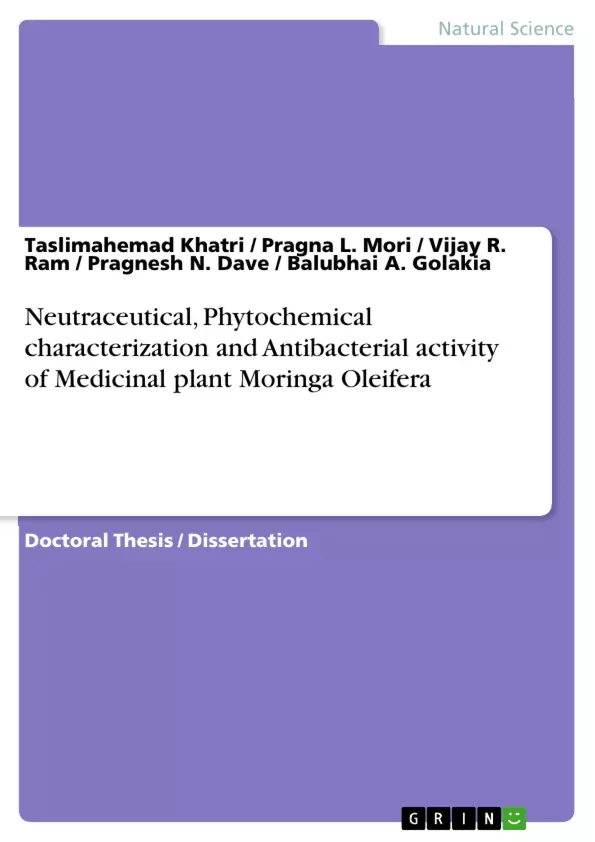Moringa oleifera, an important medicinal plant is one of the most widely cultivated species of the family Moringaceae. It is highly valued from time immemorial because of its vast medicinal properties. The present study provides all necessary information regarding of four parts such as flower, leaves, seed and pulp of moringa like biochemical, phytochemical, mineral, antibacterial activity and its nutritional value. The benefits of essential nutrients and minerals for maintaining good health were also highlighted in this study.
The results of proximate analysis of Moringa oleifera revealed that the protein (9.37%), carbohydrate (7.33%), ascorbic acid (2.10%) and total soluble sugar (0.73%) were highest in flower as compared to leaves, seed and pulp. While free amino acid (9.84%) was found to be higher in seed, total phenol (0.29%) was higher in leaves and reducing sugar (0.43%) higher in pulp of the moringa. The result of qualitative analysis of amino acid represented that lysine, glycine, threonine, valine, Isoleucine, tryptophan, alanine and cystein were present in moringa. The flower also contained higher amounts of crude fibre (0.23%) as well as moisture (90.56%), while fat (15.53%) content was found higher in seed. The dry matter (30.40%) and total ash (2.12%) content were higher in leaves. The ash content represented minerals in different amounts. The higher amount of potassium was found in flower (50.9%), seed (40.7%) and pulp (77.00%). Leaves contained higher amount of Calcium (57.18%). However Aluminum (10.00%) and Magnesium (6.07%) were found only in leaves. The result of heavy metal (zinc, lead and cadmium) and analysis represented that flower, leaves, seed and pulp have zinc (Zn), lead (Pb) and cadmium (Cd) found in lower amount then permissible limit for human body.
The results of phytochemical analysis showed that terpenoids and steroids were present in all parts of moringa. Alkaloids present only in seed. Flavonoid was present in flower and seed, saponins was present in leaves, and tannin was present in leaves and seed.
The result of antibacterial activity of different types of sample (flower, leaves. seed and pulp) of moringa showed that salmonella typhii was effectively inhibited to all the extracts studied. But Escherichia coli were not inhibited by any extract. Methanolic extract of flower, leaves, seed and pulp were highly sensitive against the salmonella typhii bacteria
Inhaltsverzeichnis (Table of Contents)
- CHAPTER I-Introduction
- CHATER II -Review and Literature
- 2.1 History of MoringaOleifera
- 2.2 Moringa Species
- 2.3 Classification MoringaOleifera
- 2.4 Common Name of Moringa Oleifera
- 2.5 Morphology and Physical Characteristics
- 2.6Distribution
- 2.7 Cultivation
- 2.8 Chemical Composition
- 2.9Biochemical Parameter
- 2.10 Photochemistry
- 2.11 Antibacterial Activity
- 2.12 Minerals
- 2.13 Use of Moringaoleifera
- CHAPTER-III MATERIAL AND METHOD
- 3.1 Experimental site
- 3.2 Experimental material
- 3.3 Glass wares and polywares
- 3.4 Chemicals and solvents
- 3.5 Biochemical parameter
- 3.6 Determination of phytochemicals
- 3.7 To record qualitative analysis of amino acid by TLC
- 3.8To assay antibacterial activity of differentextract of moringa
- 3.9 To find out mineral composition of different parts of moringa using XRF
- 3.10 Estimation of sodium by flame photometer
- 3.11 To study heavy metal in different parts of moringa using VA
- CHAPTER-IV RESULT AND DISCUSSION
- 4.1 Biochemical parameter
- 4.2 Phytochemicals analysis
- 4.3 To record qualitative analysis of amino acid by TLC
- 4.4 To Assay antibacterial activity of different extract of moringa oleifera
- 4.5To find out mineral composition of different parts of moringa using XRF
- 4.6 Estimation of sodium by Flame Photometer
- 4.7 To study heavy metal in different parts of moringa using VA
Zielsetzung und Themenschwerpunkte (Objectives and Key Themes)
This study aims to characterize the phytochemical composition and antibacterial activity of Moringa oleifera, a medicinal plant known for its diverse health benefits. The research explores the potential of Moringa oleifera as a natural source of antibacterial agents and investigates its mineral content and heavy metal presence.- Phytochemical Analysis of Moringa Oleifera
- Antibacterial Activity of Moringa Oleifera Extracts
- Mineral Composition and Heavy Metal Content in Moringa Oleifera
- Biochemical Parameters of Different Parts of Moringa Oleifera
- Potential Applications of Moringa Oleifera in Traditional Medicine and Modern Healthcare
Zusammenfassung der Kapitel (Chapter Summaries)
Chapter I-Introduction: This chapter provides a general overview of the research topic, introducing the medicinal plant Moringa oleifera and its significance in traditional medicine and modern healthcare. It highlights the importance of investigating the phytochemical composition and antibacterial activity of Moringa oleifera.
CHATER II -Review and Literature: This chapter presents a comprehensive review of existing literature on Moringa oleifera, covering its history, botanical classification, morphology, distribution, cultivation, chemical composition, biochemical parameters, photochemistry, antibacterial activity, mineral content, and traditional uses.
CHAPTER-III MATERIAL AND METHOD: This chapter outlines the experimental methodology used in the study. It details the experimental site, materials, chemicals, solvents, biochemical analysis techniques, phytochemical determination procedures, antibacterial activity assays, and mineral and heavy metal analyses.
CHAPTER-IV RESULT AND DISCUSSION: This chapter presents the results of the study, analyzing and interpreting the data obtained from the experiments. It discusses the biochemical parameters, phytochemical composition, antibacterial activity, mineral content, and heavy metal presence in Moringa oleifera.
Schlüsselwörter (Keywords)
This study focuses on the phytochemical and antibacterial properties of Moringa oleifera. The key research themes include: Moringa oleifera, medicinal plant, phytochemicals, antibacterial activity, mineral content, heavy metals, biochemical parameters, traditional medicine, and healthcare.- Citar trabajo
- Taslimahemad Khatri (Autor), Pragna L. Mori (Autor), Dr. Vijay R. Ram (Autor), Dr. Pragnesh N. Dave (Autor), Dr. Balubhai A. Golakia (Autor), 2012, Neutraceutical, Phytochemical characterization and Antibacterial activity of Medicinal plant Moringa Oleifera, Múnich, GRIN Verlag, https://www.grin.com/document/279200



